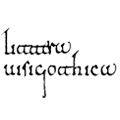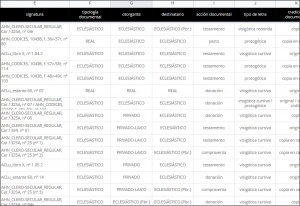ERC-project update: a comprehensive database of medieval Galician charters
Have you ever wondered how many medieval documents (between 900 and 1200) from Galicia have been preserved? Wonder no more. We have the answer.
In one of the last #ERCproject updates, I wrote about how the global pandemic (still feels odd, right?) had affected the project. I mentioned that, since we couldn’t visit the archives, we were getting much more information we were initially looking for (digital reproductions of entire repositories). So, given that our “social agenda”, all those months in which we had planned to visit archives and monasteries and arranged open talks to spread the goods news (meaning, that there was someone looking at the written history of the medieval people), could no longer be, why not take the time in using all that data to build up something new and useful? A full database of all medieval Galician written records sounds nice, don’t you think? We do too.
How have we built the database?
Being very thorough. First, we searched the catalogues of all archives we thought would have manuscripts we were interested in, all Galician archives plus the Spanish national archive in Madrid. Second, we revised all publications we knew edited – or were more likely to edit – primary sources, on the one hand just to be sure we weren’t missing anything, on the other to know whether there was any unedited material. Third, and just in case, we went back to the institutions we were studying and looked for publications on their history to see what happened to their written material, if it had been destroyed or was already on our list. We have checked these steps so many times we are reasonably sure we are not leaving anything behind.
What do we include?
When I refer to manuscripts, I not only mean charters – single sheets of parchment – both originals or copies, but also cartularies and codices – full or fragmentary. Yes, we are that mad.
From a list to a database
What did we do with all that data? All projects based on primary sources begin with a corpus. According to the first stage of the project, the compilation of such a corpus was indeed a necessity for us – gathering all documents that relate to lay people to, after analysing them, study the impact of writing on people’s lives – and, by following the steps above, we did well. However, what was intended as a mere list of references (both archival and bibliographic) has grown into something else since we haven“t only looked at the specific manuscripts we wanted, but at all manuscripts preserved.
What does this mean? It means that, while in the list we added the following fields for each document: date / institution or centre / archival reference / type of document (ecclesiastic, royal, private) / type of script, and highlighted the private-lay documents for further study, in the database you will find: date / estimated date for those documents that do not specify one / institution or centre / archive / archival reference / type of document (ecclesiastic, royal, private and specific types of each) / grantor / grantee / type of document (sale, donation, etc.) / type of script / documentary tradition (copy/original) / summary / reference to image / bibliographic reference plus some further notes on content or script.
How many sources do we have?
In a recent post we discussed we have found many more documents than expected. We have now more than 3,000 listed. We decided to organise them by dioceses (sees and monasteries, satellite or not) as culturally homogeneous areas. And so, for the diocese of Lugo we have 960, for that of Mondoñedo 519, 168 for Tuy and 583 for Orense. We are finishing Santiago de Compostela, with 893 documents already and counting.
What are we to do with this database?
We are going to share it. How? Either as an Excel spreadsheet or through a searching engine integrated on the project’s website. We haven’t decided it yet; in all honesty, I prefer the spreadsheet version for it grants access to all the data allowing any type of search and not only that designed and easy reuse of the material for one”s personal purpose. What would you prefer? I launched a survey on Twitter.
And then what?
Once we finish this database, we will further develop a smaller version for the project’s team personal use only with the lay documents, where we will add new editions of the sources plus their historical, graphic, textual, and diplomatic analysis. I expect we will make this open too. And, at the same time, we will move to VisigothicPal to do and share the graphic and diplomatic analysis while working.
So… what happened to the “social agenda”?
It has been postponed but not cancelled. We hope we will eventually be able to do at least some of the talks planned soon. In the meantime, we are organising other events. More on them soon.
Thanks for reading. Be safe.
[by A. Castro]

